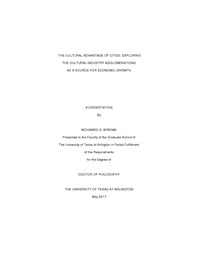
ATTENTION: The works hosted here are being migrated to a new repository that will consolidate resources, improve discoverability, and better show UTA's research impact on the global community. We will update authors as the migration progresses. Please see MavMatrix for more information.
Show simple item record
| dc.contributor.advisor | Hissong, Rod | |
| dc.creator | Bireima, Mohamed A. | |
| dc.date.accessioned | 2017-07-03T15:22:37Z | |
| dc.date.available | 2017-07-03T15:22:37Z | |
| dc.date.created | 2017-05 | |
| dc.date.issued | 2017-05-09 | |
| dc.date.submitted | May 2017 | |
| dc.identifier.uri | http://hdl.handle.net/10106/26812 | |
| dc.description.abstract | Interest in the cultural industries as a source for economic growth has risen to prominence in recent decades. The purpose of this research is to explore the role and contribution of the cultural industries for economic growth. The analytical framework is based on the agglomeration model, which links economic growth to the spatial organization of economic activity. The cultural industries exhibit a tendency to cluster in geographical space due to competitive pressures, which causes some degree of agglomeration economies to arise (Scott, 2004). The literature exploring the economic impacts of the cultural industries has focused on their agglomeration tendencies at the regional or national levels. Yet, we don't know much more about their implications at the local level or at smaller spatial scales. The research is conducted by analyzing cultural employment and socioeconomic data from the US Census from 2004 to 2014 using regression and other quantitative techniques. A zip-code level analysis is performed to determine whether variations of cultural employment explain the differences in local employment growth. The findings suggest that the cultural industries’ contribution to local economic growth is modest. The study also reveals that agglomeration economies play an important role in explaining employment growth at the local level, but are not necessarily industry-specific. The research contributes to knowledge and practice as relates to the potential role of culture in local planning and policy. The scope and implementation strategy of cultural industry agglomerations as a source of economic development may still be in its early stages, however; much further research and reflection are needed before we can draw conclusions about its full potential. Despite its limitations, the analytical framework and the findings of the study present a step forward toward understanding this role. | |
| dc.format.mimetype | application/pdf | |
| dc.language.iso | en_US | |
| dc.subject | Cultural industry | |
| dc.subject | Economic growth | |
| dc.subject | Agglomeration economies | |
| dc.title | THE CULTURAL ADVANTAGE OF CITIES: EXPLORING THE CULTURAL INDUSTRY AGGLOMERATIONS AS A SOURCE FOR ECONOMIC GROWTH | |
| dc.type | Thesis | |
| dc.degree.department | Urban and Public Affairs | |
| dc.degree.name | Doctor of Philosophy in Urban Planning and Public Policy | |
| dc.date.updated | 2017-07-03T15:24:45Z | |
| thesis.degree.department | Urban and Public Affairs | |
| thesis.degree.grantor | The University of Texas at Arlington | |
| thesis.degree.level | Doctoral | |
| thesis.degree.name | Doctor of Philosophy in Urban Planning and Public Policy | |
| dc.type.material | text | |
Files in this item
- Name:
- BIREIMA-DISSERTATION-2017.pdf
- Size:
- 656.5Kb
- Format:
- PDF
This item appears in the following Collection(s)
Show simple item record


